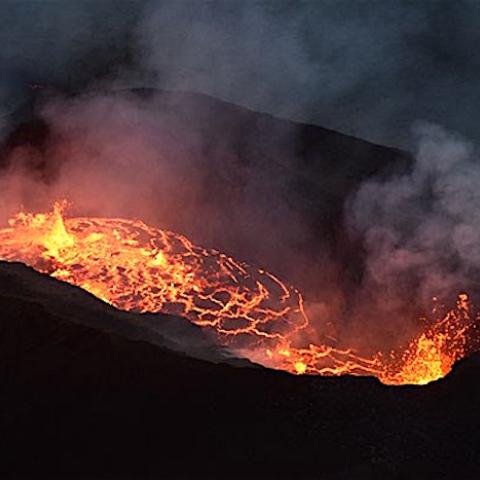
This photo of the December 23, 2024, eruption was taken from a closed area within Hawai'i Volcanoes National Park/USGS, N. Deligne
Editor's note: This updates with additional details.
A mosaic of countless fissures, some tossing fountains of molten rock more than 250 feet skyward, kicked off the latest eruption of Kīlauea volcano at Hawai'i Volcanoes National Park early Monday.
"The opening phases of eruptions are dynamic," the Hawaiian Volcano Observatory reported. "Webcam imagery shows a line of fissures erupting lava fountains feeding lava flows at the base of Halema'uma'u within Klauapele (Kīlauea's summit caldera). The activity is confined to the summit caldera and the hazards will be reassessed as the eruption proceeds."
The eruption, which began about 2 a.m. local time (7 a.m. EST), is much more vigorous than Kīlauea's last, in September when there was a slow-moving smoldering eruption in a remote area of the volcano near the Makaopuhi Crater in the park's East Rift Wilderness on the east side of the Chain of Craters Road.
While the observatory initially issued a warning for the eruption, by daybreak it downgraded that to a "watch."
"Kīlauea volcano is erupting within Halemaʻumaʻu crater in the summit caldera. As of 6:30 a.m. HST, the eruption has stabilized within the crater and there are no immediate threats to infrastructure," a release from the observatory said. "The primary hazard of concern at this time is high levels of volcanic gas which can have far-reaching effects down-wind (generally southwest) of the summit. The plume of volcanic gas and fine volcanic particles is reaching elevations of 6,000-8,000 feet above sea level (2,000-4,000 feet above ground level) and winds are transporting it to the southwest, within the closed area of Hawaiʻi Volcanoes National Park."
Along with the spectacular fountains, the eruption was spitting out "lava bombs ... from the vents on the caldera floor up onto the west caldera rim, within the closed area of Hawaiʻi Volcanoes National Park. The volcanic gas and ejecta hazards west of the erupting vents stress the hazardous nature of this closed area of Kīlauea's summit. By 5:30 a.m., lava covered an estimated area of 400 acres of the caldera floor," the release added.
Kīlauea is one of the youngest and most active volcanoes in the world, so some volcanic activity is certainly not unusual.




 Support Essential Coverage of Essential Places
Support Essential Coverage of Essential Places






